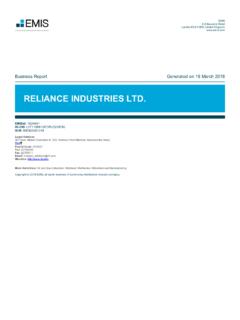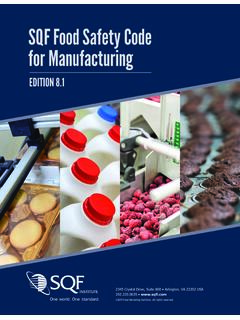Transcription of The Use of Enzymes in Food Processing: A Review
1 South Asian Journal of Food Technology and Environment ISSN 2394-5168 (Print), 5454-6445 (online) 2015 Society for World Environment, Food and Technology 190 The Use of Enzymes in Food Processing: A Review Sorabh Chaudhary1*, Sushma Sagar1, Mukesh Kumar1, Sengar1 and Akash Tomar2 1 Department of Agriculture Biotechnology and 2 Department of Recombinant Techniques Sardar Vallabhbhai Patel University of Agriculture and Technology, Meerut- 250110 ( ) *Email:- Abstract Enzymes are protein molecules functioning as specialized catalysts for chemical reactions.
2 Enzymes have always been important to food technology because of their ability to act as catalysts, transforming raw materials into improved food products. Food processing Enzymes are used as food additives to modify food properties. Food processing Enzymes are used in starch processing, meat processing, dairy industry, wine industry and in manufacture of pre-digested foods. The present Review extends the frontier of enzyme technology towards food processing applications and discusses the important characteristics of various Enzymes and its sources, used in food industries.
3 Various methods of enzyme immobilization for food processing applications have also been discussed in detail. Keywords: Enzymes , Food processing, Food industry, Immobilization, Enzyme technology Paper cited: Chaudhary, S., Sagar, S., Kumar, M., Sengar, and Tomar, A. (2015). The use of Enzymes in food processing: A Review . South Asian Journal of Food Technology and Environment, 1(3&4): 190-210. Received: 07/09/2015 Revised: 15/10/2015 Accepted 25/10/2015 Introduction The term enzyme is derived from the Latin word meaning in yeast . Enzymes are proteins, produced by living organisms to increase the rate of an immense and diverse set of chemical reactions required for life.
4 In other words, they are highly specific biological catalysts. They are involved in all processes essential for life such as, DNA replication and transcription, protein synthesis, metabolism, cell regulation and signal transduction often via kinases and phosphatases (Hunter, 1995). They are also generate movement, with myosin hydrolysing adenosine triphosphate (ATP) to generate muscle contraction and also moving cargo around the cell as part of the cytoskeleton (Berg et al., 2001). Enzymes are usually named according to the reaction they carry out.
5 Typically, the suffix ase is added to the name of the substrate ( glucose-oxidase, an enzyme which oxidizes glucose) or the type of reaction ( a polymerase or isomerasefor a polymearization or isomerization reaction). The exceptions to this rule are some of the Enzymes studies originally, such as pepsin, rennin and trypsin. The international Union Biochemistry (IUB) initiated standards of enzyme nomenclature which recommend that Enzymes names indicate both substrates acted upon and the type of reaction catalyzed.
6 Detailed information on nomenclature can be found on the IUB homepage (IUB Homepage). Their ability to perform very specific chemical transformations has made them increasingly useful in industrial processes. Enzymes have been exploited by human for thousands of years. Food processing through the use of biological agents is historically a well-established approach. The earliest applications go back to 6,000 BC or earlier, with the brewing of beer, bread baking, and cheese and wine making whereas the first purposeful microbial oxidation dates from 2,000 BC, with vinegar production (Vasic-Racki, 2006; Poulsen and Buchholz, 2003; Schafer et al.)
7 , 2002). The epoch of classical biotechnology was marked by landmark discoveries of microbes by Leeuwenhook of fermentation as biological processes by Pasteur, of Enzymes as protein by Buchner and of the first enzyme crystal structures by summer. In the middle of the nineteenth century, Northrop and Stanley developed a South Asian Journal of Food Technology and Environment ISSN 2394-5168 (Print), 5454-6445 (online) 2015 Society for World Environment, Food and Technology 191 complex procedure for isolating pepsin.
8 Their precipitation technique has since been used to crystallize many Enzymes . Pectinases were used for juice clarification in the 1930s, and for a short period during World War II, invertases were also used for the production of invert sugar syrup in a process that pioneered the use of immobilized Enzymes in the sugar industry (Vasic-Racki, 2006). A few years later, for the first time, an enzyme (a protease) was produced by fermentation of Bacillus licheniformis. In this, way, large-scale production of Enzymes became possible, thus facilitating the industrial application of Enzymes .
9 Still, the large-scale application of Enzymes only became really established in the 1960s, when the traditional acid hydrolysis of starch was replaced by an approach based in the use of amylases and amyloglucosidaes (glucoamylases), a cocktail that some years later would include glucose (xylose) isomearse (Fernandes, 2010a; Leisola, 2002). Enzymes are currently among the well-established products in biotechnology (Norus, 2006), from US $ billion to US $ billion in 2013; it is expected to have reached aroynd US $ billion by 2018, a compound annual growth rate (CAGR) of from 2013 to 2018 (Bon and Ferrara, 2007; World Enzyme Study, 2013).
10 Part of this market is ascribed to Enzymes used in large-scale applications, among them are those used in food and feed applications (Binod et al., 2008). These include Enzymes used in baking, beverages and brewing, dairy, dairy supplements, as well as fats and oils, and they have typically been dominating one, only bested by the segment assigned to technical Enzymes (Berka and Cherry, 2006; Kirk et al., 2002). Enzymes in Food Processing In the twentieth century, Enzymes began to be isolated from living cells, leading to a large-scale commercial production and with wider application in the food industry.



